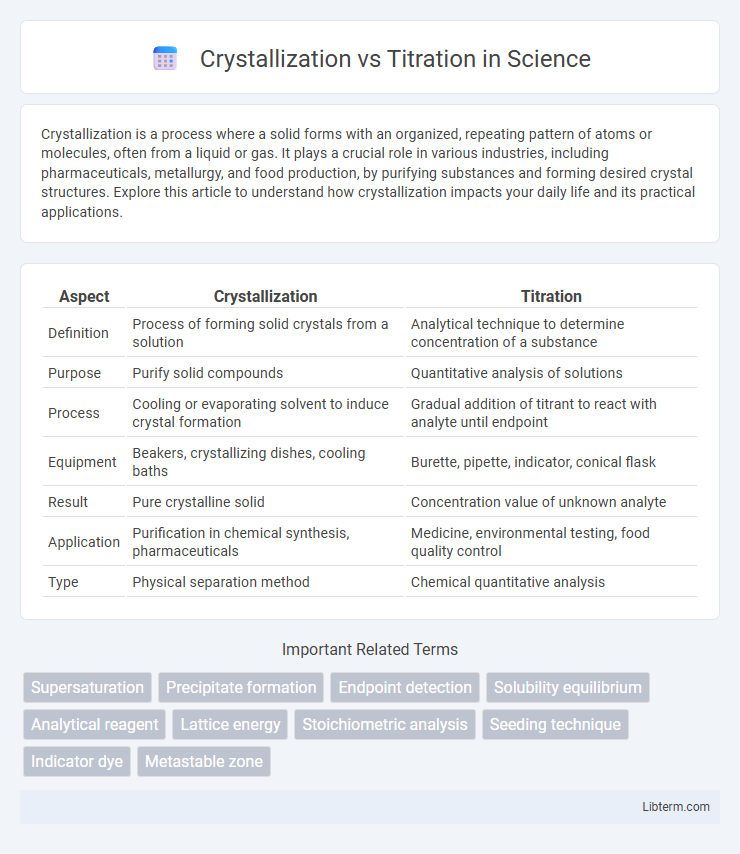Crystallization is a process where a solid forms with an organized, repeating pattern of atoms or molecules, often from a liquid or gas. It plays a crucial role in various industries, including pharmaceuticals, metallurgy, and food production, by purifying substances and forming desired crystal structures. Explore this article to understand how crystallization impacts your daily life and its practical applications.
Table of Comparison
| Aspect | Crystallization | Titration |
|---|---|---|
| Definition | Process of forming solid crystals from a solution | Analytical technique to determine concentration of a substance |
| Purpose | Purify solid compounds | Quantitative analysis of solutions |
| Process | Cooling or evaporating solvent to induce crystal formation | Gradual addition of titrant to react with analyte until endpoint |
| Equipment | Beakers, crystallizing dishes, cooling baths | Burette, pipette, indicator, conical flask |
| Result | Pure crystalline solid | Concentration value of unknown analyte |
| Application | Purification in chemical synthesis, pharmaceuticals | Medicine, environmental testing, food quality control |
| Type | Physical separation method | Chemical quantitative analysis |
Introduction to Crystallization and Titration
Crystallization is a purification technique that involves the formation of solid crystals from a homogeneous solution, driven by changes in temperature or concentration. Titration is an analytical method used to determine the concentration of an unknown solution by reacting it with a titrant of known concentration, often monitored using indicators or pH meters. Both methods play crucial roles in chemical analysis, with crystallization emphasizing solid formation and purification, while titration focuses on precise quantification of chemical species.
Core Principles of Crystallization
Crystallization is a purification technique based on the principle of solubility differences, where a solute forms solid crystals from a saturated solution upon cooling or evaporation. The process relies on nucleation and crystal growth, allowing selective separation of pure compounds from impurities. Titration, by contrast, is a quantitative method involving the gradual addition of a reagent to determine concentration, and does not involve phase changes or solid formation like crystallization.
Core Principles of Titration
Titration is an analytical technique based on the quantitative reaction between a titrant of known concentration and an analyte to determine the analyte's concentration precisely. The core principle involves the gradual addition of the titrant until the reaction reaches the equivalence point, often indicated by a color change or pH shift. This method contrasts with crystallization, which separates substances by forming solid crystals from a solution without directly measuring concentration.
Key Differences Between Crystallization and Titration
Crystallization separates compounds based on solubility differences by forming solid crystals from a solution, while titration quantifies substance concentration through a chemical reaction with a titrant. Crystallization is primarily a purification technique, whereas titration is an analytical method used to determine the concentration of an unknown solution. The process of crystallization involves cooling or evaporating a solution, contrasting with titration's precise addition of a reagent until the reaction endpoint is reached.
Applications of Crystallization in Industry
Crystallization is widely applied in the pharmaceutical industry for purifying active ingredients, ensuring drug potency and stability. In the food industry, crystallization is essential for sugar refining and salt production, delivering consistent product quality. Chemical manufacturing also relies on crystallization to isolate and purify compounds with high precision, improving overall process efficiency.
Applications of Titration in Laboratories
Titration is widely used in laboratories for determining the concentration of unknown solutions in chemical analysis, quality control, and pharmaceutical testing. It enables precise quantification of acids, bases, oxidizers, and reducers in various samples, making it essential for titrimetric analysis. Unlike crystallization, which isolates pure substances, titration provides rapid, accurate, and reproducible results crucial for experimental and industrial processes.
Equipment and Materials Required
Crystallization requires a hot plate or heating mantle, glass beakers, evaporating dishes, and suitable solvents to dissolve and recrystallize the target compound. Titration involves using a burette for precise liquid measurement, a conical flask, pipettes, and standardized titrant solutions along with indicators to detect the end point. Both methods demand accurate measurement tools but differ significantly in the nature of materials and apparatus based on their distinct chemical processes.
Advantages and Limitations of Crystallization
Crystallization offers high purity in isolating specific compounds by selectively forming solid crystals from a solution, making it ideal for purification in pharmaceuticals and chemical synthesis. The process is cost-effective and environmentally friendly due to minimal solvent use but requires precise control of temperature and concentration to achieve optimal crystal formation. Limitations include its unsuitability for impure or complex mixtures, lower efficiency for large-scale operations, and the potential for slow processing times compared to titration methods.
Advantages and Limitations of Titration
Titration offers precise quantitative analysis with high accuracy and reproducibility, making it ideal for determining concentration in various chemical solutions. Its limitations include susceptibility to human error during endpoint detection and the need for standardized reagents to ensure reliable results. Unlike crystallization, titration provides rapid results but may not be suitable for analyzing substances that lack a sharp color change or clear endpoint.
Choosing the Right Technique: Crystallization vs Titration
Choosing between crystallization and titration depends on the analytical goal and sample properties; crystallization is ideal for purifying and isolating solid compounds based on solubility differences, while titration excels in quantifying concentration of a specific analyte in solution through precise volumetric reaction. Crystallization suits scenarios requiring solid form recovery or purity enhancement, especially for organic solids or salts, whereas titration is preferred for acid-base, redox, or complexometric analysis in liquid samples. Selecting the appropriate method optimizes accuracy, efficiency, and the integrity of chemical analysis outcomes.
Crystallization Infographic

 libterm.com
libterm.com